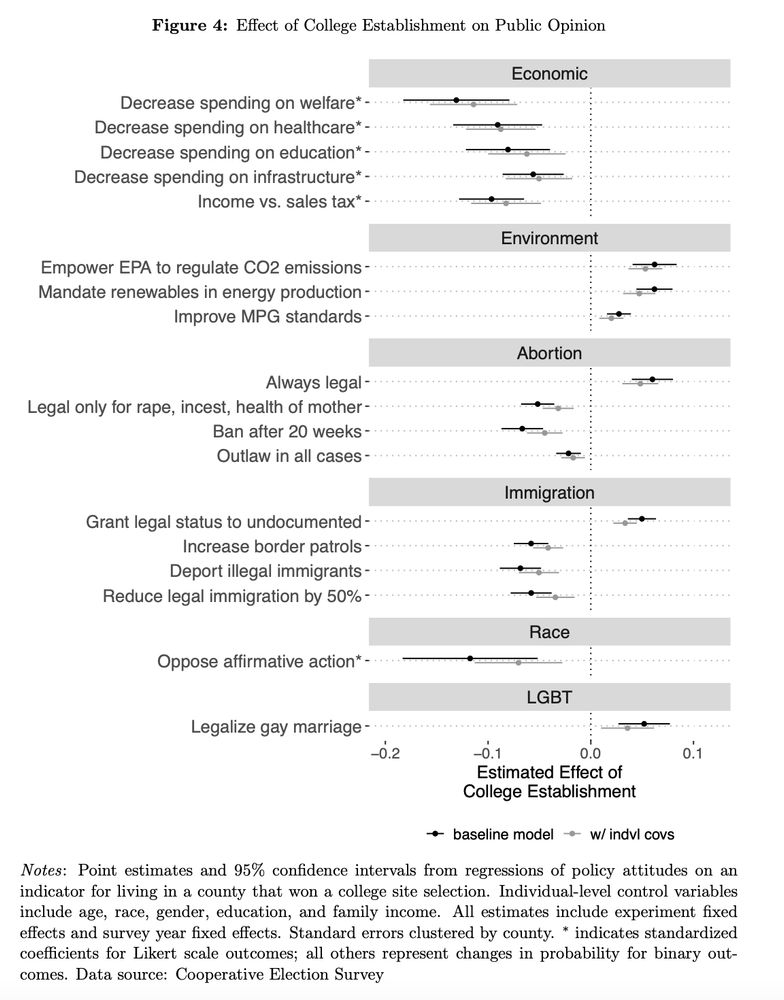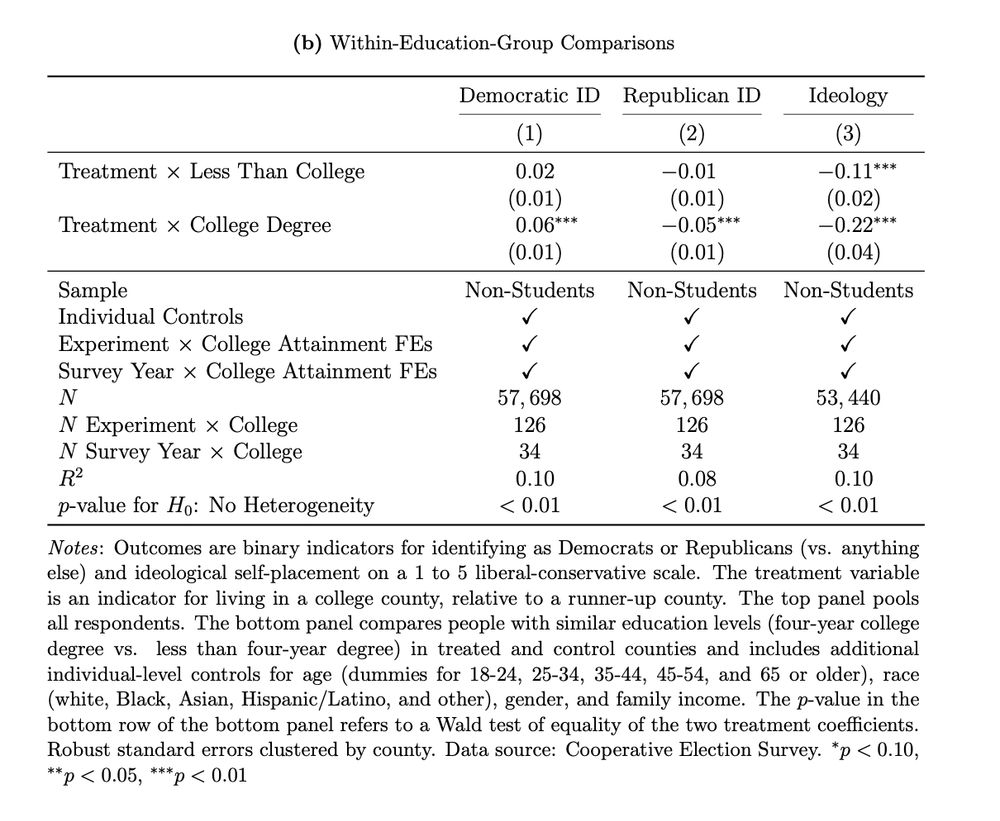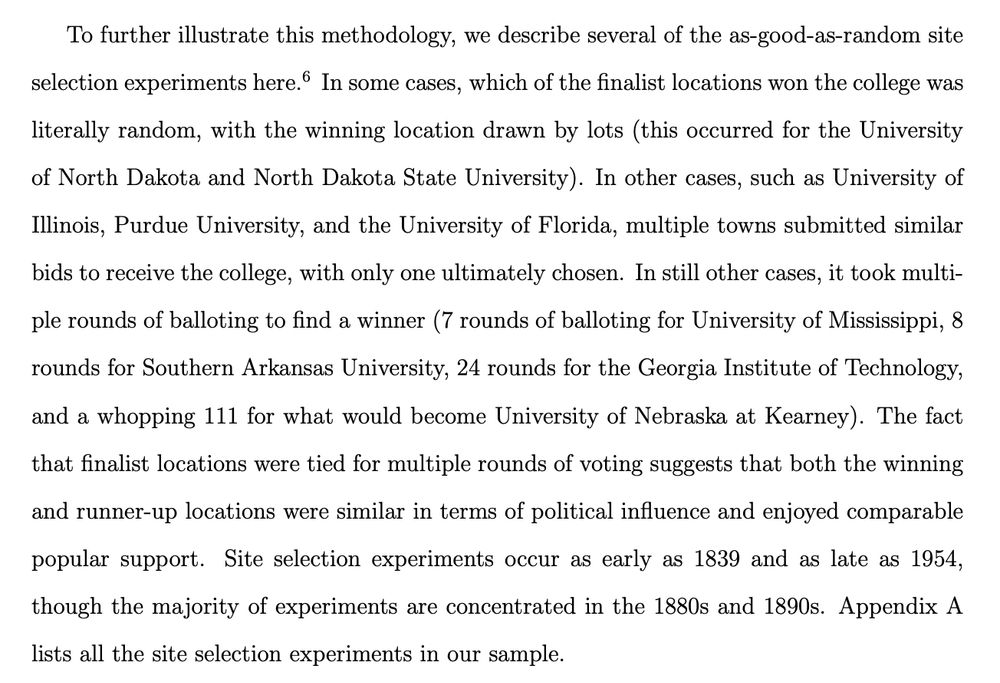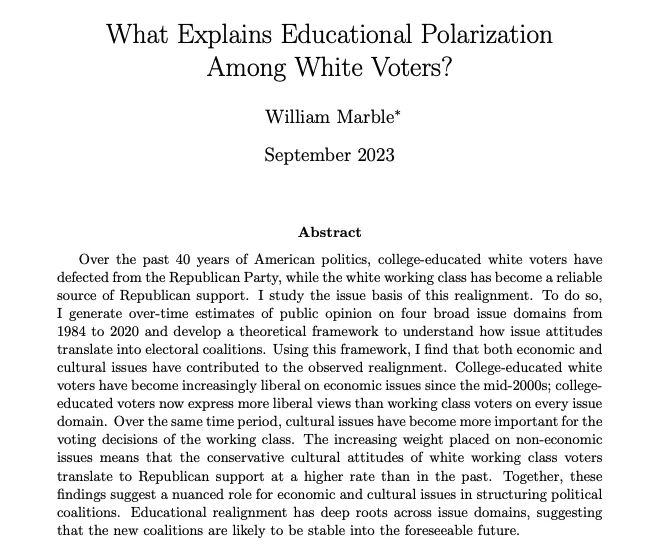Will Marble
@wpmarble.bsky.social
Political scientist at the Hoover Institution at Stanford || williammarble.co
There are also differences in contemporary public opinion: people living near colleges are more liberal on a range of issues. These attitudinal differences are not solely driven by the presence of students nor by differences in the average educational attainment in the community.


July 17, 2025 at 9:43 PM
There are also differences in contemporary public opinion: people living near colleges are more liberal on a range of issues. These attitudinal differences are not solely driven by the presence of students nor by differences in the average educational attainment in the community.
From Reconstruction through the end of the 20th century, there were minimal differences in voting patterns between places with a university and "runner-up" locations. Since 2000, though, a gap has emerged, with college counties becoming significantly more Democratic. In 2024 this gap was ~10pp.

July 17, 2025 at 9:43 PM
From Reconstruction through the end of the 20th century, there were minimal differences in voting patterns between places with a university and "runner-up" locations. Since 2000, though, a gap has emerged, with college counties becoming significantly more Democratic. In 2024 this gap was ~10pp.
The establishment of a college also leads to a county casting significantly more votes in presidential elections—an effect that's explained by a population growth channel rather than a turnout rate channel.

July 17, 2025 at 9:43 PM
The establishment of a college also leads to a county casting significantly more votes in presidential elections—an effect that's explained by a population growth channel rather than a turnout rate channel.
We find that places with colleges have significantly higher levels of social capital and trust today, relative to "runner-up" locations that were considered but not chosen.


July 17, 2025 at 9:43 PM
We find that places with colleges have significantly higher levels of social capital and trust today, relative to "runner-up" locations that were considered but not chosen.
How do universities shape the surrounding community? Building on meticulous archival work by my co-author Mike Andrews, we answer this question by focusing on cases where multiple locations were considered for a major university and the winning location was chosen for idiosyncratic reasons.

July 17, 2025 at 9:43 PM
How do universities shape the surrounding community? Building on meticulous archival work by my co-author Mike Andrews, we answer this question by focusing on cases where multiple locations were considered for a major university and the winning location was chosen for idiosyncratic reasons.
Universities often serve as "anchor institutions" that deeply affect the character of their communities. In a new paper, we estimate how (and when) the establishment of a college influences local political and civic life. 🧵
osf.io/preprints/so...
osf.io/preprints/so...

July 17, 2025 at 9:43 PM
Universities often serve as "anchor institutions" that deeply affect the character of their communities. In a new paper, we estimate how (and when) the establishment of a college influences local political and civic life. 🧵
osf.io/preprints/so...
osf.io/preprints/so...
The claim that Trump is just "enforcing immigration law" is ridiculous given that the administration has repeatedly *violated immigration law* by detaining/deporting people without due process.

June 10, 2025 at 9:59 PM
The claim that Trump is just "enforcing immigration law" is ridiculous given that the administration has repeatedly *violated immigration law* by detaining/deporting people without due process.
Work on conjoint survey experiments in political science is relevant here--the classic cite is Hainmueller et al 2014, who are clear about the estimand in the "short" model averaging over the interactions. The notation is a bit gnarly in that paper though...
www.cambridge.org/core/journal...
www.cambridge.org/core/journal...


October 5, 2023 at 6:52 PM
Work on conjoint survey experiments in political science is relevant here--the classic cite is Hainmueller et al 2014, who are clear about the estimand in the "short" model averaging over the interactions. The notation is a bit gnarly in that paper though...
www.cambridge.org/core/journal...
www.cambridge.org/core/journal...
Why does economic decline seem to benefit right-wing parties in the U.S. and Europe? Junghyun Lim and I propose an explanation rooted in the interplay between social arrangements and economic geography.
osf.io/preprints/so...
osf.io/preprints/so...
![Title page for a paper called "Migration, Social Ties, and Political Preferences" by William Marble and Junghyun Lim. Abstract: Why have economically declining regions turned toward right-wing parties? To explain this puzzling phenomenon, we develop a theory linking internal migration, localized social institutions (e.g., family and friend networks), and voters’ preferences for social insurance. We start with the observation that social ties provide insurance against adverse life events, such as job loss, and highlight two implications. First, those with strong social networks prefer lower spending on social insurance, because they have access to informal insurance that acts as a substitute for public programs. Second, social ties discourage people from moving, even when better economic opportunities are available in other regions. Combining these mechanisms, we argue that the effect of economic shocks on a region’s politics depends on the strength of social ties.[continued]](https://cdn.bsky.app/img/feed_thumbnail/plain/did:plc:ry53mh6kuivkexbqkunuqbhy/bafkreift4x4i2mqnwatjrdggbawbfx3so5ssisirsvx4za7s7ce3imvhe4@jpeg)
September 25, 2023 at 7:30 PM
Why does economic decline seem to benefit right-wing parties in the U.S. and Europe? Junghyun Lim and I propose an explanation rooted in the interplay between social arrangements and economic geography.
osf.io/preprints/so...
osf.io/preprints/so...
The framework I use here enables a principled interpretation of the correlation between vote choice and attitudes. There are issues of causality that I discuss in the paper. It's not perfect, but IMO this framework provides important insights into the nature of voting decisions.

September 18, 2023 at 5:18 PM
The framework I use here enables a principled interpretation of the correlation between vote choice and attitudes. There are issues of causality that I discuss in the paper. It's not perfect, but IMO this framework provides important insights into the nature of voting decisions.
3) The relative weight that whites w/o college degrees placed on cultural issues was low until the mid-2000s—limiting the returns Republicans could reap from the WWC's conservative cultural attitudes. Now, the weight placed on cultural issues is identical for the two groups.


September 18, 2023 at 5:18 PM
3) The relative weight that whites w/o college degrees placed on cultural issues was low until the mid-2000s—limiting the returns Republicans could reap from the WWC's conservative cultural attitudes. Now, the weight placed on cultural issues is identical for the two groups.
The upshot is that there is now consistent polarization across issue domains between whites with and without a college degree.

September 18, 2023 at 5:17 PM
The upshot is that there is now consistent polarization across issue domains between whites with and without a college degree.
2) The white working class has long been more conservative than college-educated voters on cultural issues. But in the past ~20 years, college-educated voters have become significantly more liberal on economic issues as well.

September 18, 2023 at 5:17 PM
2) The white working class has long been more conservative than college-educated voters on cultural issues. But in the past ~20 years, college-educated voters have become significantly more liberal on economic issues as well.
I present sever findings:
1) Ideological constraint has increased dramatically among both college-educated and non-college-educated voters, expanding the possibilities for group-based polarization.
1) Ideological constraint has increased dramatically among both college-educated and non-college-educated voters, expanding the possibilities for group-based polarization.

September 18, 2023 at 5:17 PM
I present sever findings:
1) Ideological constraint has increased dramatically among both college-educated and non-college-educated voters, expanding the possibilities for group-based polarization.
1) Ideological constraint has increased dramatically among both college-educated and non-college-educated voters, expanding the possibilities for group-based polarization.
I use survey data to generate issue-specific ideal point estimates for Economics, Moral/Social Issues, Race, and Foreign Policy. I introduce a framework that enables me to decompose differences in vote choice into different preference distributions and different issue weights.



September 18, 2023 at 5:17 PM
I use survey data to generate issue-specific ideal point estimates for Economics, Moral/Social Issues, Race, and Foreign Policy. I introduce a framework that enables me to decompose differences in vote choice into different preference distributions and different issue weights.
I study this transformation over ~40 years, asking which issues have contributed most to this realignment.

September 18, 2023 at 5:16 PM
I study this transformation over ~40 years, asking which issues have contributed most to this realignment.
First, the well-known realignment: In 1992, GHWB won 45% of white voters w/o a college degree and 52% of those with a college degree. In 2020, Trump won 65% of non-college whites and just 42% of whites with a degree. The college divide is widening.

September 18, 2023 at 5:16 PM
First, the well-known realignment: In 1992, GHWB won 45% of white voters w/o a college degree and 52% of those with a college degree. In 2020, Trump won 65% of non-college whites and just 42% of whites with a degree. The college divide is widening.
The white working class has steadily become part of the Republican base while whites w/ college degrees have become Democratic. In a new paper, I study the issue basis of this realignment, showing that both economic and cultural issues have contributed.
williammarble.co/docs/EducPol...
williammarble.co/docs/EducPol...

September 18, 2023 at 5:15 PM
The white working class has steadily become part of the Republican base while whites w/ college degrees have become Democratic. In a new paper, I study the issue basis of this realignment, showing that both economic and cultural issues have contributed.
williammarble.co/docs/EducPol...
williammarble.co/docs/EducPol...
No help on the other site, trying here: What is the easiest way to step through/debug a function using tidyeval in R? With base R I can just run this code line-by-line interactively after assigning the args in the global environment. But AFAIK the {{ }} tidyeval syntax only works inside a function.

August 19, 2023 at 8:06 PM
No help on the other site, trying here: What is the easiest way to step through/debug a function using tidyeval in R? With base R I can just run this code line-by-line interactively after assigning the args in the global environment. But AFAIK the {{ }} tidyeval syntax only works inside a function.
Small model detail: w/ brms term (1 | id | group), the random intercept for each individual j is b_j ~ MVN(0, Sigma). The correlation matrix for Sigma has LKJ(1) prior by default.
(This comes from looking at generated stan code, so could be wrong. I couldn't find clear documentation.)
(This comes from looking at generated stan code, so could be wrong. I couldn't find clear documentation.)


August 12, 2023 at 8:46 PM
Small model detail: w/ brms term (1 | id | group), the random intercept for each individual j is b_j ~ MVN(0, Sigma). The correlation matrix for Sigma has LKJ(1) prior by default.
(This comes from looking at generated stan code, so could be wrong. I couldn't find clear documentation.)
(This comes from looking at generated stan code, so could be wrong. I couldn't find clear documentation.)
Glad the new proposal raises the arena floor to accommodate Jefferson Station, but it's hard to tell whether it's enough to save the natural lighting that Inga Saffron has highlighted in the Inquirer. AFAIK still no word on whether the new proposal would require MSG-style pillars thru the station.

August 9, 2023 at 5:06 PM
Glad the new proposal raises the arena floor to accommodate Jefferson Station, but it's hard to tell whether it's enough to save the natural lighting that Inga Saffron has highlighted in the Inquirer. AFAIK still no word on whether the new proposal would require MSG-style pillars thru the station.

